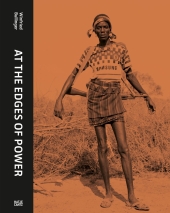 Neuerscheinungen 2017Stand: 2020-02-01 |
Schnellsuche
ISBN/Stichwort/Autor
|
Herderstraße 10
10625 Berlin
Tel.: 030 315 714 16
Fax 030 315 714 14
info@buchspektrum.de |

Hubertus von Amelunxen, Winfried Bullinger
(Beteiligte)
Winfried Bullinger
An den Rändern der Macht / At the edges of Power
.
2017. 304 S. m. 180 Abb. 30 cm
Verlag/Jahr: HATJE CANTZ VERLAG 2017
ISBN: 3-7757-4260-3 (3775742603)
Neue ISBN: 978-3-7757-4260-3 (9783775742603)
Preis und Lieferzeit: Bitte klicken
Fokus Afrika: Eindrückliche Porträts in Schwarz-Weiß
An den Rändern der Macht ist eine konzeptionell angelegte Portrait-Arbeit von Winfried Bullinger (geb. 1965 in München) über Menschen in Afrika. Angehörige der Nuer, der Afar, der Karamajong und anderer Stämme leben und überleben durch einen hohen Grad an Eigenständigkeit und Abgrenzung. Die Bilder des Buches sind während zahlreicher Expeditionen in einem Zeitraum von zehn Jahren mit einer Großformatkamera in den Ländern Sudan, Äthiopien, Kenia, Uganda, Tanzania und der Zentralafrikanischen Republik entstanden. Winfried Bullinger zeigt Portraits von Personen, die für den Moment der Aufnahme ihren Weg und ihre Arbeit unterbrechen. Der Aufnahmeort ist der Ort des Treffens. Die Portraitierten tragen die Kleidung und die Ausrüstungen des Moments. In einer bislang ungesehenen Art und Weise gelingt es dem Künstler durch seine eigene Sichtweise, den komplexen Zusammenhang zwischen Individuum und der Geschichte seiner Gemeinschaft im Bild zu fassen.
At the Edges of Power is Winfried Bullingers ( 1965 in Munich) conceptual work of portraiture about people in Africa. Members of the Nuer, the Afar, the Karamajong, and other tribes live and survive thanks to a high degree of independence and delimitation. The pictures in this book were shot with a large-format camera on numerous expeditions undertaken over a period of ten years in the countries of Sudan, Ethiopia, Kenya, Uganda, Tanzania, and the Central African Republic. Bullinger presents portraits of people who stop on their paths or interrupt their work for the brief seconds it takes to shoot a photograph. The photographs were taken on the sites of these encounters. The people depicted wear the clothing and carry the equipment they had at that moment. In a way previously unseen, the artist succeeds in capturing images of the complex connection between the individual and the history of his community.


